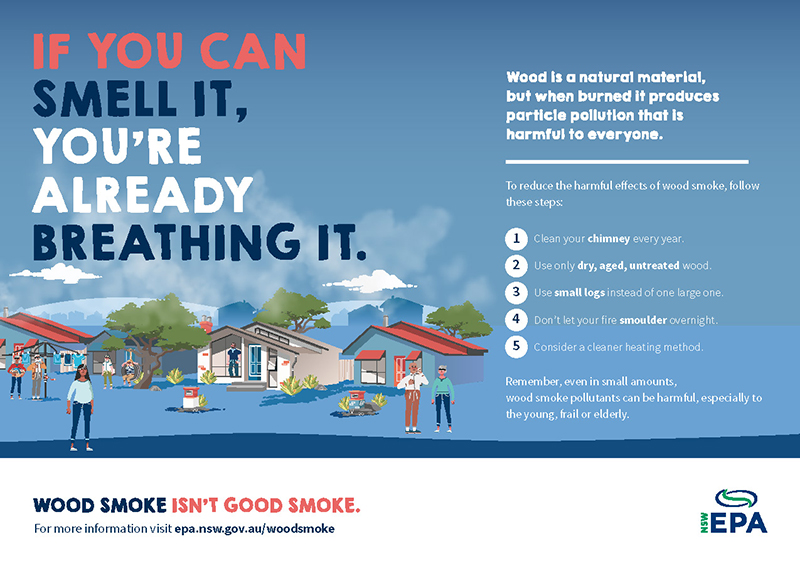Pollution and Open Burning
During the winter, the smoke from domestic wood heaters causes air pollution. Wood smoke pollution affects everyone. It is bad for your health and the health of others in your community. Things you can do to prevent wood smoke pollution include burn only dry wood, never let your heater smolder overnight, keep the flame lively and bright, check to see if your chimney is smoking and have your chimney cleaned every year.
New Legislation commenced on 1 May 2006 giving Council Officers the power to issue smoke abatement notices and on-the-spot fines of $200 to house occupiers that allow excessive smoke to be emitted from chimneys on or in residential premises. A smoke abatement notice directs a householder to undertake necessary improvements, maintenance or repairs to ensure excessive smoke is not emitted from their chimneys.
What is Excessive Smoke?
The POEO Act of 1997 defines excessive smoke as the emission of a visible plume or smoke from a chimney for a continuous period of not less than 10 minutes, including a period of not less than 30 seconds when the plume extends at least 10 metres from the point at which the smoke is emitted from the chimney.
What Causes Excessive Smoke?
Common operational causes of excessive smoke include insufficient kindling, too much firewood in the heater, turning the air control to slow burn too soon after light-up or refuelling, trying to burn a single large log, adding firewood without opening the air control, an incorrectly placed log which blocks the air supply to the base of the fire and the use of wood that is too wet. Common installation or maintenance issues that cause excessive smoke include heater flue is clogged with creosote and needs to be swept (symptoms of a clogged flue are the heater is difficult to start or smoke enters the room when the heater door is opened), flue length is too short for adequate 'draw' (the flue is an important component of the woodheater installation and needs to be long enough to draw sufficient air for proper combustion of the fuel), poor location of heater and/or flue (a woodheater will perform better in terms of both heating effectiveness and reduced smoke emissions when located towards the centre of the home and not against an outside wall) and DIY repairs such as those that leave the heater with missing components or the baffle plate incorrectly installed.
For further information call Council's Environmental Health Officer or visit the Woodsmoke Reduction Program.

Open Burning
Under the NSW Control of Burning Regulation, rubbish cannot be burnt and vegetation can only be burnt in residential and rural residential subdivisions following approval from Council. Permits are also required by the Rural Fire Service within the Statutory Fire Danger Period (usually 1 October - 31st March each year). If you wish to burn vegetation within a residential or rural residential subdivision, please complete the Application Form or contact Council.
The burning of rubbish and vegetation in urban areas can result in complaints about adverse public health effects. It is also a significant contributor to air pollution in urban areas. Some materials commonly burnt within commercial and residential areas (such as paper and cardboard which could be recycled), is unnecessary. However, the burning of vegetation in or near urban areas causes the most community concern.
Environmental Responsibility
Councils and communities can work together to reduce local environmental damage that occurs when natural vegetation and fauna habitat is burnt. This will also lower the risk of uncontrolled fires which pose a risk to persons and properties.
Greenwaste
The disposal of garbage or vegetation by burning is generally not necessary as waste collection services are available in residential areas. Reduced disposal fees apply at Landfills for small loads of green waste (delivered by car, trailer or utility). Disposal fees for larger loads delivered by trucks are reasonable and this waste vegetation is often recycled and used for mulching.
Last modified:
25 Aug 2021